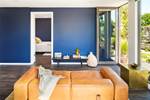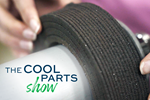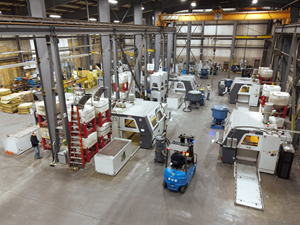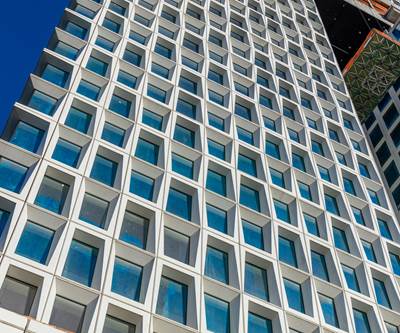The ability to 3D print with concrete promises interesting geometries and faster construction of buildings, homes and other structures with less labor and greater automation than is the current norm. But at Oak Ridge National Laboratory’s Manufacturing Demonstration Facility, building layer by layer with concrete also opens the opportunity to embed functional items inside of that structure. The EmPower Wall, built using the MDF-developed SkyBAAM cable-driven concrete 3D printer, incorporates cooling water lines to help conserve energy and save cost. 3D printing may also help to reduce the amount of concrete needed to build structures, and by extension the energy embedded in producing that concrete. This episode is one of several filmed on-site at the MDF. | This episode of The Cool Parts Show brought to you by Carpenter Additive
The Cool Parts Show is a video series from Additive Manufacturing Media that explores the what, how and why of unusual 3D printed parts. Watch more here.
Have a cool part to share? Email us.
Related Resources
- More on the EmPower Wall
- What Is the Manufacturing Demonstration Facility at Oak Ridge National Laboratory? (video)
- Other examples of 3D printing in construction
- Another episode of The Cool Parts Show filmed at the MDF, on 3D printed magnets
Transcript
Stephanie Hendrixson
On this episode of The Cool Parts Show, additive manufacturing and construction.
Pete Zelinski
We'll talk about this cool 3D printed wall and the 3D printer that made it.
Pete Zelinski
The Cool Parts Show is brought to you by Carpenter Additive. When it comes to managing metal powder there is no one size fits all approach. Stick around after the episode to learn more.
Pete Zelinski
I'm Pete.
Stephanie Hendrixson
I'm Stephanie.
Pete Zelinski
Welcome to The Cool Parts Show.
Stephanie Hendrixson
This is our show all about cool, unique, interesting 3D printed parts. And we are filming today in the Manufacturing Demonstration Facility, part of Oak Ridge National Labs. We are here to talk about the cool part behind us this 3D printed wall.
Pete Zelinski
Okay, so some of the people who watch the show, they are accustomed to seeing us with parts in front of us, usually holding parts showing off parts. Is a wall a part?
Stephanie Hendrixson
If you think about the way that building construction works, I would argue you could think of it as on site manufacturing. You have all of these discrete parts that you need to assemble together, you're trimming things to fit, you're finishing different surfaces, if you're dealing with concrete is basically sort of like molding it on site. And so construction is a little bit like bringing the factory to your build site. Speaking of which, we are here to talk about this wall. But we're also here to talk about the thing that made this wall, the SkyBAAM, a new way of building concrete.
Pete Zelinski
Bringing the factory to the construction site. So SkyBAAM, big 3D printer for concrete. How do you make a 3D printing system so big, it is bigger than the wall you might build, bigger than the structure that you might use to build it with? And so the answer is that what is essentially the printhead for depositing concrete rides on these cables that are set up at the job site. And laser tracking ensures geometrically precise deposition of the concrete exactly where it should go. So we're going to learn a lot more about the SkyBAAM, about 3D printing concrete, about the possibilities it's realizing. But first, start at the beginning. Why? Why 3D print concrete?
Stephanie Hendrixson
So that's a good question. If you think about how you would typically build something like a concrete wall, the very first step, it starts with a form. Basically, a mold or a tool that you're going to pour the concrete into, so that it can set up it can cure it can be the right shape that you need it to be. But doing that adds a lot of lead time to the project. You can't do anything until you have that formwork in place. It puts restrictions on the types of geometries you can build. And you'll also probably wind up using more concrete than you might actually need. The advantage of printing with something like SkyBAAM, and the sort of specialized concrete mix that they use with it is that you don't need that form work, you can do sort of freeform shapes in all kinds of different geometries, and actually end up using less concrete at the end of it because you're only applying exactly what you need.
Pete Zelinski
Alright, I'm with you, concrete is way cool. So let's bring in someone now who was instrumental in developing the SkyBAAM system. Here is Brian Post, he is group leader of the Manufacturing Systems Design Group. He's a robotics guy who's now a concrete enthusiast.
Brian Post
I knew nothing about concrete before we got into this. And it's been a really interesting field to learn. So there are so many different types of concrete, so many varieties, so many things you can do with it, it's a really exciting material. So traditional concrete is designed to flow into formwork. And it takes the shape of whatever box you put it in. So it's more of a liquid than a solid. The printing concrete is really different in that what you want to be able to do is pump it really easily so that it flows through a concrete line all the way to the deposition head. And then once it leaves the nozzle, you want it to hold its shape and stay really firm so that you can support the weight of subsequent layers as you're printing. And so we're balancing all these really interesting characteristics like set time versus the amount of additives we put in it for flow, versus the water reducers we put in the mix to get the strength properties, it's a really specialized blend of concrete. And so we've had to work with industrial partners like Quikrete to develop these specialized blends, because it's so far away from what the traditional concrete industry uses. So what concrete 3D printing allows you to do is actually print without the forms to create that external structure for your system. And then you can treat it either like a traditional concrete pour, where you fill in the rest of it or you can, you know, optimize the geometry of your structure to make better use of the material itself. So concrete 3D printing really allows you the design freedom that you don't have in traditional concrete construction.
Pete Zelinski
So Brian mentioned design freedom. Let's talk about that. Because this wall is not a typical wall is it?
Stephanie Hendrixson
That's right, the EmPower Wall is something special. A lot of times with 3D printing, when you're building up a form layer by layer, you have the opportunity to put other things in between those layers. And that's the case here, the EmPower Wall actually has water lines running through it.
Pete Zelinski
So during off peak periods, cool water circulates through the wall, the temperature difference is held in place with controllable insulation, during a hot part of the day, turn off the insulation and take advantage of this coolness. Oak Ridge in one of their conference rooms has one of these walls. And when the day gets hot, it's like you just turn on the wall and coolness comes off of it.
Brian Post
So the EmPower Wall is a demonstration article. So the idea is that we're going to do some tech validation of smart wall structures. And so the the basic premise is that the EmPower Wall is a battery, we can store energy in this wall and then release it to the environment as needed to offset the energy utilization of the heating, ventilation and air conditioning systems in the building. And so what happened is we print the wall structure embedding in tubes and sensing systems so that we can charge the wall with energy when it's at its lowest costs by heating and cooling that large concrete structure. And then we have active insulation on the outside. And so that insulation allows us to either turn it on or turn it off to prevent energy from leaving the wall structure or allow energy to leave the wall structure. So essentially, we can charge it like a big battery at night when the energy is low cost and available. Or you could charge it through the day through renewable energy resources that you have on your building. And then in the day when the peak demand times occur when people enter the building in the morning, you can use energy that's stored in the wall to offset the demand from the HVAC system, shaving the peaks of demand usage and allowing you to reduce the overall energy that the building consumes.
Stephanie Hendrixson
So one of the interesting things about this wall is it's not meant to be like a replacement for your HVAC system. It's a supplement or a complement to that system that can provide those additional energy savings. So you mentioned the wall that's in the conference room, and just in that one room, they've seen something like 6% energy savings from having that wall.
Pete Zelinski
But there's a little more going on than that isn't there? We've had this chance to learn a lot about concrete and and its nuances. And there is tons of concrete out there. And it's not a super energy efficient material, is it?
Stephanie Hendrixson
That's right. And so as we've seen in other instances of additive manufacturing, allowing you to use less material, that's the case here with concrete. And that's very important, because concrete is a very energy intensive material to make.
Brian Post
So the way that concrete is manufactured, it starts with cement. And so cement is a combination of limestone and clays that has been heated up in a furnace up to about 2500 degrees Celsius. So it's a really hot furnace. And so there's a lot of fuel oil and hydrocarbons that go into manufacturing the cement itself. And then the limestone is calcium carbonate. So there's a co2 component that actually burns off in the formation of cement. And so there's a lot of energy that's embodied in the cement itself and there's a lot of co2 that's off-gassed to the environment from that production process. And so it's a very energy intensive material, and it has a lot of negative carbon footprint associated with it. What additive manufacturing allows you to do is actually use or make optimal use of the material form itself. And so we can reduce the amount of material that goes into end-use structures and reduce the total consumption of concrete compared to the way that we do it conventionally. Which could have significant impact on the energy portfolio of the United States. Furthermore, we're starting to look at ways in which we can make more traditional, and by traditional I mean ancient concrete. So before the invention of Portland cement, most people will use aerial lime mortars. Those are limestone that co2 has been brought off of, and then it cures by bringing that co2 back in and completing what's called the lime cycle. And those are actually co2, neutral concrete and very low energy, you only have to get them up to 800 C instead of 2500 degrees Celsius. And so if we can enable those kinds of technologies through additive manufacturing, we can have a huge impact in the total energy utilization of the concrete industry.
Stephanie Hendrixson
So when you start to think in terms of energy usage like that, there's actually a lot of energy needed for building construction. You have all of the energy expended in actually building the structure, but there's also the energy embedded in producing the materials that you need. And then there's the way that you use the finished building at the end of it. And 3D printing has wins for all three of those in terms of energy.
Pete Zelinski
All right, I think we got this. So, this is the EmPower Wall, 3D printed concrete wall. Is it a cool part? It is. And the reason why is because this is an example of how additive manufacturing brings the possibilities of manufacturing into contexts, into problems and solutions beyond what we would have imagined before. So here is additive manufacturing. Now applied to building, to home building. Here is additive manufacturing brought to the construction site.
Stephanie Hendrixson
This wall was built with SkyBAAM, a cable driven 3D printer using a specialized concrete mix that's guided by lasers. SkyBAAM allows you a lot of flexibility in terms of both the size and shape of the structure that you can build, you don't need a printer that's larger than the wall or whatever it is that you might need to create, because it's such a flexible system. The other advantages of sky BAM are that you can create concrete structures such as walls without any formwork, which opens up a lot of geometric possibilities, and also allows you to use that resource that material more conservatively.
Pete Zelinski
And it is a different way of making a wall, making a different kind of wall because a special feature of this wall is the internal cooling passages that allow this wall to support and be a complement to the building's air conditioning. It's a cool wall literally a cool part.
Stephanie Hendrixson
I think we'll leave it there. Thank you again to Oak Ridge for hosting us. If you want to find all of the episodes we're filming here at the MDF, check out our YouTube channel or TheCoolPartsShow.com.
Pete Zelinski
If you have an idea for a cool 3D printed part you'd like to share like to tell us about does not have to be as big as a wall, email us CoolParts@AdditiveManufacturing.media.
Stephanie Hendrixson
If you liked the show, we hope you'll subscribe, leave us a like leave us a comment. And as always, thanks for watching.
Pete Zelinski
This episode's brought to you by Carpenter Additive, we're past the point of not knowing how to qualify metal 3D printed parts. We know it's just that different end users of those parts have different qualification requirements. Additive manufacturing service providers have to navigate that. And Carpenter Additive has to think about that in tailoring powder management solutions.
William Herbert
Our customers typically will have, if they are a service provider, they will have a series of end user customers who may be say OEMs in the aerospace world. And each of them has a fairly large team of engineers who've been doing this for decades or more, and have developed all these standards, regulations, paperwork. So it is certainly a challenge to thread the needle between all of these different requirements. We start really high level we walk on the shop floor, we asked them about their source to sink, how do you bring him in materials goods in, send that material to each of the systems. And then what we're really interested in is how do they reuse that material. So what we do is called a Value Stream Map. Pretty often that leads to a series of things that were either overlooked or hadn't really boiled up to the surface yet in terms of things that are potential risks, or potential challenges or inefficiencies that exist. A lot of the customers we work with, especially in the more regulated industries, such as space or medical, or aerospace, have already been through those early learning stages. They've put five plus years into this. They've done the product design and the design for additive manufacturing. And now they're starting to reach some of the more finicky problems that you get when you're at the scale of maybe 5 or 10 machines. You're running different materials simultaneously. You're doing different programs. We get to take the best from the medical field and the aerospace field. We understand the specifications, and the standards the exist in each of those fields. And we can sort of take the best elements of those and customize that to our customers.
Related Content
DMG MORI: Build Plate “Pucks” Cut Postprocessing Time by 80%
For spinal implants and other small 3D printed parts made through laser powder bed fusion, separate clampable units resting within the build plate provide for easy transfer to a CNC lathe.
Read MoreLooking to Secure the Supply Chain for Castings? Don't Overlook 3D Printed Sand Cores and Molds
Concerns about casting lead times and costs have many OEMs looking to 3D print parts directly in metal. But don’t overlook the advantages of 3D printed sand cores and molds applied for conventional metal casting, says Humtown leader.
Read MoreVideo: 5" Diameter Navy Artillery Rounds Made Through Robot Directed Energy Deposition (DED) Instead of Forging
Big Metal Additive conceives additive manufacturing production factory making hundreds of Navy projectile housings per day.
Read MoreCombining Metal and Polymer for Better 3D Printed Tools
Applications prone to wear call for more durable tooling than 3D printed polymer alone, but full metal is not always necessary.
Read MoreRead Next
Concrete Facade Made with 3D Printed Tooling Now Complete
The One South First building in Brooklyn features a concrete facade fully covering its 45 stories. 3D printed tooling played a key part.
Read More3D Printed Prefab Homes, Made from Composite and UL-Certified
Mighty Buildings wants to change the construction industry with prefabricated houses 3D printed on demand from thermoset polymer composite. Two such buildings have already been installed.
Read More3D Printed Magnets: The Cool Parts Show #38
Is it possible to 3D print a magnet? In this episode of The Cool Parts Show, we learn how magnets have been printed successfully at Oak Ridge National Lab, and the implications this has for energy, material conservation and supply chains.
Read More

.jpg;width=70;height=70;mode=crop)

















